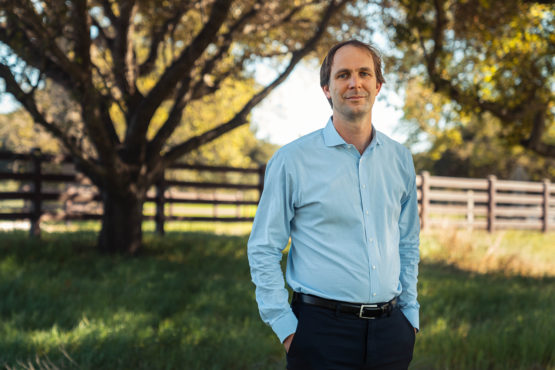Peers’ experiences help inform Stanford’s strategy for limiting COVID-19 spread on campus
In preparing for more undergraduates on campus winter quarter, Stanford is examining the effectiveness of COVID approaches among other institutions and is working to raise awareness of guidelines for healthy behaviors.
Stanford has been going to school on peer institutions’ pandemic experiences with bringing undergraduate students back to campus.

Russell Furr is associate vice provost for environmental health and safety. (Image credit: Andrew Brodhead)
Those lessons learned, as well as Stanford’s own after many graduate and professional students and a limited number of undergraduates returned this fall, are instructive as the university prepares for more undergraduates to return for winter quarter.
“We’ve been following the experiences of our peer institutions, especially those where significant numbers of students have returned to campus already,” said Russell Furr, associate vice provost for environmental health and safety. “The scenarios we’ve heard about and the examples we’ve observed reflected a range of approaches.”
“Some outcomes have been encouraging, others cautionary,” Furr said, “but one approach stands out: The campuses with really good testing compliance usually manage to catch infectious individuals early and limit the scope of spread. That’s how it is supposed to work.”
A number of considerations and scenarios have influenced colleges’ plans and outcomes. Stanford officials have been evaluating others’ results, in addition to procedures already in place on the Farm, where most graduate students and postdoctoral scholars as well as undergraduates with special circumstances were in residence during autumn quarter.
Among the approaches that schools must consider:
- Frequency of testing and whether it should be required or just encouraged
- Role of systems for self-reporting daily health status (such as Stanford’s Health Check) and to what extent compliance should be linked to campus access
- Where to draw the line on requirements for face coverings, especially in outdoor environments
- How to balance the risk of gatherings with the need for some level of social interaction
- The desire to limit campus visitors but allow access to essential visitors, especially those critical to students’ health and well-being
Furr said every category has gradations, and local conditions and governmental requirements vary. But the results are instructive.
Learning from experience and adapting
“As we began reopening the campus, we looked to public health and medical professionals to limit the spread through testing, contact tracing and quarantine/isolation,” Furr said. “Despite their positive impact, those steps would not be adequate by themselves. So we have also looked to limit the spread by changing the environment, changing behavior and redesigning processes – and I think other universities’ experiences support the importance of these steps.”
For example, he said, schools with comprehensive approaches – including mandatory, regular testing and strong buy-in from students – have seen relatively low levels of COVID-19 cases. Schools with voluntary testing programs have not only experienced significant spikes and clusters of positive tests, but also found that symptomatic students skipped tests altogether because they wanted to avoid quarantines, reduced campus activities and other consequences.
Earlier this month, Provost Persis Drell announced Stanford’s winter quarter plans for having frosh, sophomores, new transfer students and other undergraduates who have approved academic, athletic or personal exceptions on campus. She said the university’s strategy, which extends across the campus community, must balance a number of factors and evolve.
“Our goal is to gradually resume university activities, including bringing undergraduates back to campus, in a safe manner,” Drell said. “No precise formula exists and not everything works as envisioned. But we’re all in this together – working with each other and learning from each other’s experiences. Strong safeguards, the flexibility to adjust as appropriate, and a healthy dose of empathy and patience continue to be crucial to our efforts.”
The surveillance testing program, which was implemented in August and will include mandatory twice weekly testing for students at the beginning of the winter quarter, and hygiene best practices are central to those efforts. A rigorous testing approach will enable the university to identify positive results rapidly, notify contacts and isolate those testing positive, in order to blunt spread of the virus and outbreaks.
Encouraging healthy behaviors
Vice Provost for Student Affairs Susie Brubaker-Cole underscored the importance of people understanding precautions and guidelines for community living, the reasons they’re being implemented and the benefits of following them.
Awareness, cooperation and participation are pivotal, she said. That’s why her office is developing a COVID-19 healthy behaviors campaign to remind students about what’s needed for them to keep themselves and each other as safe and healthy as possible.
“It all comes down to our community buying into the process,” Brubaker-Cole said. “We know students want to be back on campus and we’re excited to have more and more of them back. We’ll be working closely with them to help them understand the approaches that work best – how abiding by testing and other requirements enables them to have the experiences they want and deserve.”
Approaches and results have varied at campuses across the country, and the outcomes have included a number of success stories.
Kathryn Ann “Kam” Moler, vice provost and dean of research, said the combination of collaboration at Stanford and the experiences of other colleges and universities bodes well as the number of those studying and working on campus grows.
“With more people returning and interactions growing,” Moler said, “we really appreciate what every member of our community is doing to make sure that we all stay safe together: working remotely as much as possible, following protocols when you must come to work, wearing face coverings, physical distancing, getting tested and using the Health Check tool.”
